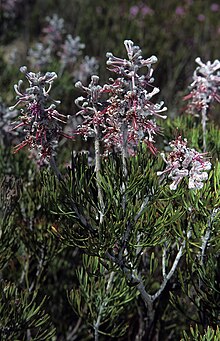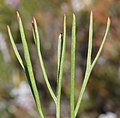| This article needs additional citations for verification. Please help improve this article by adding citations to reliable sources. Unsourced material may be challenged and removed. Find sources: "Paranomus dispersus" – news · newspapers · books · scholar · JSTOR (January 2022) (Learn how and when to remove this message) |
| Paranomus dispersus | |
|---|---|

| |
| Conservation status | |
 Least Concern (IUCN 3.1) | |
| Scientific classification | |
| Kingdom: | Plantae |
| Clade: | Tracheophytes |
| Clade: | Angiosperms |
| Clade: | Eudicots |
| Order: | Proteales |
| Family: | Proteaceae |
| Genus: | Paranomus |
| Species: | P. dispersus |
| Binomial name | |
| Paranomus dispersus Levyns | |
Paranomus dispersus, the long-head sceptre, is a flower-bearing shrub that belongs to the genus Paranomus and forms part of the fynbos. The plant is native to the Western Cape, South Africa.
Description

The shrub grows up to 1.5 m (4.9 ft) tall and flowers mainly from August to November. Fire destroys the plant but the seeds survive. The plant is bisexual and pollinated by insects. The fruit ripens, two months after flowering, and the seeds fall to the ground where they are spread by ants.
In Afrikaans, it is known as langkopsepter.
Distribution and habitat
The plant occurs from the Great Winterhoek Mountains to the Riviersonderend Mountains to the Outeniqua Mountains and Swartberg and Rooiberg. It grows in sandstone sand at altitudes of 300–1,200 m (980–3,940 ft).
Gallery
References
- Rebelo, A.G.; Mtshali, H.; von Staden, L. (2020). "Paranomus dispersus". IUCN Red List of Threatened Species. 2020. IUCN: e.T113201256A157950293. doi:10.2305/IUCN.UK.2020-3.RLTS.T113201256A157950293.en.
External links
 Media related to Paranomus dispersus at Wikimedia Commons
Media related to Paranomus dispersus at Wikimedia Commons- "Threatened Species Programme | SANBI Red List of South African Plants". redlist.sanbi.org. Retrieved 2022-01-06.
- "Paranomus dispersus (Long-head sceptre)". biodiversityexplorer.info. Retrieved 2022-01-06.
- "Common Sceptres". proteaatlas.org.za. Retrieved 2022-01-06.
| Taxon identifiers | |
|---|---|
| Paranomus dispersus | |











